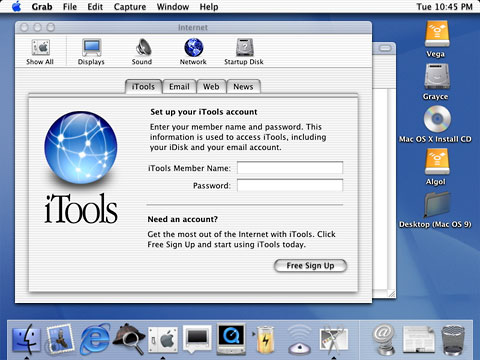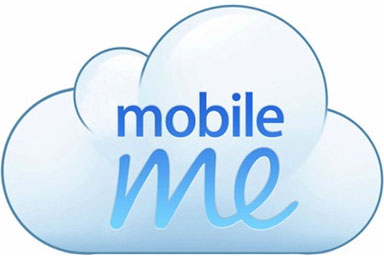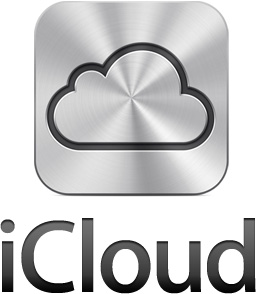Over the years Apple has received a lot of flack over MobileMe and its
performance, mainly because a lot of people simply didn't understand
the way it worked.
Few people today know how it got started, and even fewer realize
that it actually shaped the world that we take for granted today (in
much the same way Apple's Lisa
computer did). Today I will share the story of the unappreciated
super cloud that changed the world.
iTools, 2000-2002
Twelve-and-a-half years ago, Apple launched a service that would
eventually start the "cloud" revolution. That service was called
iTools, and it was revolutionary.

MobileMe began life as Apple's free iTools service in 2000.
iTools offered a host of features exclusive to Mac users running the
then-current Mac OS
9. iTools would eventually be called .Mac, then MobileMe, and
finally iCloud.
iTools was a truly revolutionary service. It was the first service
freely available to consumers that gave them their own cloud (called
iDisk) to store their documents, photos, videos, websites, and other
information. Its other features were a free email account (anything you
wanted @mac.com), KidSafe (Internet filtering for kids that focused on
what kids can look at, as opposed to what they can't look at), HomePage
(a web hosting service), and, one of my favorites, iCards (e-cards that
you could send your friends of Apple products).
While a number of these services were available from other providers
for free, Apple was the only one that gave you an integrated
experience, and the iDisk was an amazing step forward.
- iTools for Mac required Mac OS 9 through OS X 10.x. There was also
a version for Windows XP.
.Mac, 2002-2008
Ten years ago this month, Apple discontinued iTools and replaced it
with a subscription-based service called .Mac (pronounced dot-Mac).
.Mac was designed to give customers an even better, more integrated
experience than iTools by adding in features such as more iDisk
capacity (100 MB as opposed to 20 MB), McAfee virus protection software
(this was before Apple was advertising the Mac as a virus-free
platform), automatic backup function to iDisk, and Address Book/iCal
publishing functionality.

.Mac added several new features to iTools at $99 per year.
But all of this additional functionality came at a price. The free
iTools service was dropped, and .Mac replaced it for $99 per year.
Apple gave existing users the option to subscribe to .Mac for 50% off
for the first year, then the normal subscription fee after that. This
left a sour taste in the mouths on many people who had come to believe
that Steve Jobs had implied that the @mac.com email address that they
had setup using iTools would be "free for life".
.Mac had a very rocky existence. Many people believed that it made
more sense to simply shop around and "stitch together" the various
services that .Mac offered from other providers that gave them away for
free. While this approach worked for some people, others found that the
way .Mac integrated everything made everything easier - and for the
most part it did.
 In January 2003, .Mac
started including some pretty advanced new features, including the
ability to keep your Address Book, iCal calendars, and Safari bookmarks
synced across multiple Macs using a new application called iSync. This was a pretty big
breakthrough, because now you could access your information from any
Mac, and if you made any changes they would be reflected on your other
Macs as soon as you synced them with iSync. .Mac also started offering
new perks just for members, such as free and discounted software and
free online training courses. Later that year the included storage
jumped from 100 MB to 250 MB.
In January 2003, .Mac
started including some pretty advanced new features, including the
ability to keep your Address Book, iCal calendars, and Safari bookmarks
synced across multiple Macs using a new application called iSync. This was a pretty big
breakthrough, because now you could access your information from any
Mac, and if you made any changes they would be reflected on your other
Macs as soon as you synced them with iSync. .Mac also started offering
new perks just for members, such as free and discounted software and
free online training courses. Later that year the included storage
jumped from 100 MB to 250 MB.
When Mac OS X 10.4 Tiger
launched in 2005, .Mac started including even more features. Among the
new features were support for syncing Mail accounts and signatures,
Calendars, Contacts, Keychains, and Bookmarks automatically
without using the iSync app. This was exciting, because you
would no longer have to manually sync your Macs to .Mac, furthering the
integration and ease of use.
Later in 2005 Apple also increased the storage from 250 MB to 1
GB.
.Mac received a pretty major make over in 2006. It had even more
integrated services that made things easier. If you used iWeb to create your website,
you could use .Mac to host it by simply clicking Publish in
iWeb. You could also share your photos from iPhoto with a single click
that would send your photos in their full quality to the .Mac
Gallery.
Updates in 2007 were also significant. When Mac OS X 10.5 Leopard was launched in
October of 2007, .Mac received some new features, including the ability
to automatically sync Dock items and user settings (including your
Desktop Picture!) across multiple machines.
Back to my Mac (BTTM) also made its debut with Leopard. BTTM was a
pretty revolutionary idea that would let you connect to your home/work
Mac from a second Mac remotely, access all of its files, and even
remotely control it with a built-in VNC utility. This feature is still
one of my favorites to show off and is still available with iCloud.
- .Mac for Mac requires Mac OS X 10.2 through 10.5.x.
MobileMe, 2008-2012
At the WWDC in June 2008, when the iPhone 3G was introduced, Apple
announced that .Mac was being replaced by an entirely new service
called MobileMe.
Apple had decided that in order for .Mac to be successful, it needed
to be completely rebuilt from the ground up. MobileMe was designed to
work with the new iPhone OS (version 2.0) - and Windows computers in
addition to Macs. It didn't made sense to keep calling the service .Mac
when it was no longer limited to Macs.

MobileMe was Apple's first multiplatform cloud service.
MobileMe was basically the same as .Mac, except it received a whole
new web interface that allowed you to add information to your calendars
and contacts, and share files with your friends by sending them a
special link to your iDisk. It also increased the included storage from
10 GB to a whopping 20 GB. However, it did drop a number of features
that .Mac had on the website, including the ability to see your Safari
bookmarks from any computer, and iCards were no longer there.
In the first few days following the launch of MobileMe, it was was
plagued with system outages, sync data corruption, data loss, and other
issues. The data loss was primarily caused by the fact that many people
would log their empty iPhones into MobileMe, not realizing that
everything on their Cloud was being replaced by their empty iPhone. It
was clear that Apple did not anticipate that people might accidentally
replace the info that was already in their cloud with the data on an
empty iPhone, and they also didn't expect the high level of demand that
would be placed on their servers when MobileMe launched. It was a
recipe for disaster.
MobileMe quickly earned a reputation for being unreliable, but it
didn't take long for Apple to take action. Apple quickly realized that
it needed to have phones merge information into the cloud
instead of replacing it. This has a tendency to duplicate information
if it is on both the iPhone and on the Cloud at the same time (which is
still true today), but that is a lot better than loosing all of that
data.
When iPhone OS 3.0 was released in the summer of 2009, it included a
surprise feature for MobileMe users, one that made people flock to
MobileMe (at lease for awhile). It was called
Find My iPhone, and it allowed you to track your iPhone in the
event it was lost or stolen. This was way ahead of its time, and it
didn't take long for other phone manufacturers to start incorporating
this type of feature into their smart phones.
MobileMe remained largely unchanged after that, until it was
announced that it would be replaced by another new service called
iCloud. MobileMe was discontinued on June 30, 2012.
- MobileMe required Mac OS X 10.4.11 through 10.7.1.
iCloud, Free at Last!
 In June 2011,
Steve Jobs made his final keynote presentation. At that presentation he
introduced iCloud to the world. iCloud is a service that takes the
essential features of MobileMe (syncing Mail, Contacts, Calendars,
Bookmarks, Photos, and Notes) and streamlines everything so that it is
very easy to use (in most cases you won't even know you're using it).
It will also sync documents, app purchases, music purchases, and iBook
purchases across multiple iDevices, and it still gives you the Back to
my Mac function if you want to use it. iCloud includes 5 GB of free
storage, which can be upgraded, and it no longer features iDisk (which
I feel is a huge bummer) or Photo Gallery. It also will no longer host
your website.
In June 2011,
Steve Jobs made his final keynote presentation. At that presentation he
introduced iCloud to the world. iCloud is a service that takes the
essential features of MobileMe (syncing Mail, Contacts, Calendars,
Bookmarks, Photos, and Notes) and streamlines everything so that it is
very easy to use (in most cases you won't even know you're using it).
It will also sync documents, app purchases, music purchases, and iBook
purchases across multiple iDevices, and it still gives you the Back to
my Mac function if you want to use it. iCloud includes 5 GB of free
storage, which can be upgraded, and it no longer features iDisk (which
I feel is a huge bummer) or Photo Gallery. It also will no longer host
your website.
The best part about iCloud is that it is free, so you could say that
Apple has come full circle and decided that its cloud service probably
should have been free all along.
When iCloud was announced, folks who already had MobileMe had their
subscription extended until June 30, 2012 and were given 25 GB of free
storage until September of 2012.
- iCloud for Mac requires Mac OS X 10.7.2 or newer. On iDevices, it
requires iOS 5. On PCs, it supports both Windows Vista SP2 and
Windows 7.
It really is the end of an era. I'm really going to miss my iDisk. I
suppose I need to sign up for a free Dropbox account so that I still have access
to files on the go.
iCloud has come a long way since it was first introduced as iTools
in January 2000, and I hope that you now see why it was the
unappreciated super cloud that changed the world.

Chris Carson is a longtime Mac user and a more recent convert to iPhone and iPad.



 In January 2003, .Mac
started including some pretty advanced new features, including the
ability to keep your Address Book, iCal calendars, and Safari bookmarks
synced across multiple Macs using a new application called
In January 2003, .Mac
started including some pretty advanced new features, including the
ability to keep your Address Book, iCal calendars, and Safari bookmarks
synced across multiple Macs using a new application called 
 In June 2011,
Steve Jobs made his final keynote presentation. At that presentation he
introduced iCloud to the world. iCloud is a service that takes the
essential features of MobileMe (syncing Mail, Contacts, Calendars,
Bookmarks, Photos, and Notes) and streamlines everything so that it is
very easy to use (in most cases you won't even know you're using it).
It will also sync documents, app purchases, music purchases, and iBook
purchases across multiple iDevices, and it still gives you the Back to
my Mac function if you want to use it. iCloud includes 5 GB of free
storage, which can be upgraded, and it no longer features iDisk (which
I feel is a huge bummer) or Photo Gallery. It also will no longer host
your website.
In June 2011,
Steve Jobs made his final keynote presentation. At that presentation he
introduced iCloud to the world. iCloud is a service that takes the
essential features of MobileMe (syncing Mail, Contacts, Calendars,
Bookmarks, Photos, and Notes) and streamlines everything so that it is
very easy to use (in most cases you won't even know you're using it).
It will also sync documents, app purchases, music purchases, and iBook
purchases across multiple iDevices, and it still gives you the Back to
my Mac function if you want to use it. iCloud includes 5 GB of free
storage, which can be upgraded, and it no longer features iDisk (which
I feel is a huge bummer) or Photo Gallery. It also will no longer host
your website.
